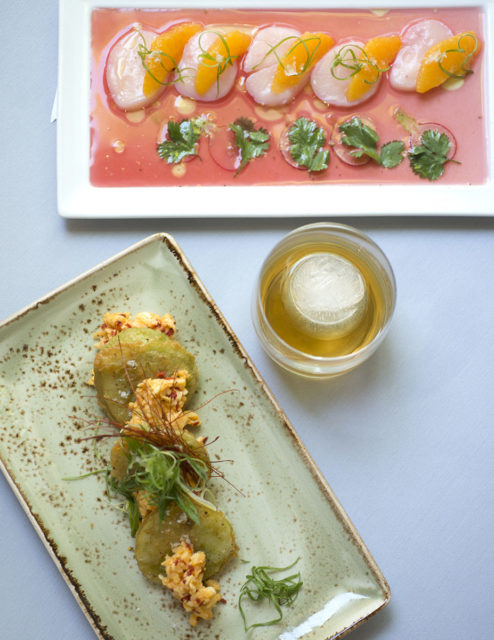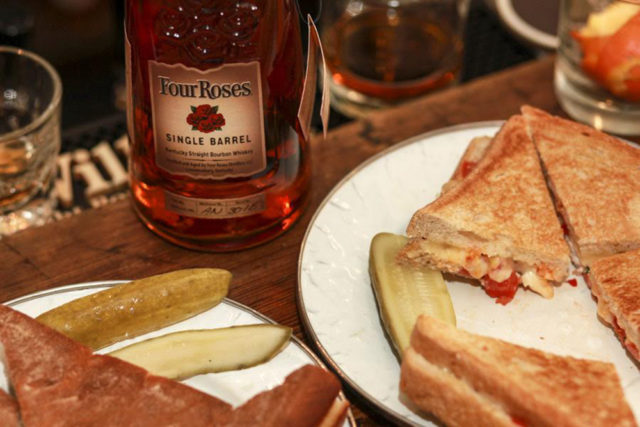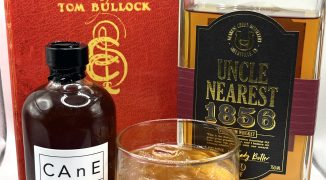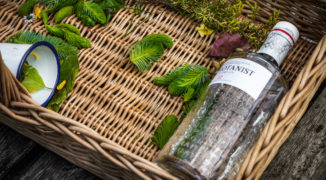With the rise of high-end bourbons and whiskeys, craft beer and wine may have some new competition when it comes to being paired with food. Having all the flavor complexities of its lower ABV cousins, bourbon and whiskey are no longer sitting on the sidelines as digestifs. Whiskey bars with food concepts — like Radish and Rye in Santa Fe and Noorman’s Kil in Brooklyn — are inviting patrons to experience the spirits as an accompaniment to au courant dishes on innovative menus.
What’s the key to successfully pairing whiskey with food? Michael Sebree, bartender at Radish and Rye, views pairing as following the same vein as cocktail theory. “You look at how the spirit was made and what you can pull out,” Sebree says. “With bourbons and Scotches, you might get some chocolate notes. You get some high end mineral qualities with Scotches, and nutty flavors imparted by the wood. Just like you would consider these qualities when mixing a drink, you can pronounce those parts when you’re pairing with them with food.”
A career bartender with more than 20 years of experience in Europe and New York, Sebree points to his upbringing on a farm in Kentucky as responsible for his “strong bourbon game” and an early foundation in fresh, farm-to-table flavors. Radish and Rye features a seasonal menu with ingredients sourced as locally and freshly as possible. When pairing dishes with selections from the expertly curated bourbon menu (which includes custom single barrels from Buffalo Trace Distillery), Sebree considers how flavor notes from a spirit might parallel or contrast what might be found in a particular food preparation.
For example, Sebree marries grilled lamb ribs with spicy Salbitxada sauce alongside Stagg Jr., an unfiltered Kentucky bourbon that clocks in at a toasty 132 proof. The strong rye and clove notes of the Stagg Jr. hold up against the spiciness of the sauce, and the high-proof burn also cuts pleasantly with the fatty, caramelized sweetness of the grilled meat.
 At Radish and Rye, the staff considers how a whiskey was made to pair it appropriately with their farm-to-table themed food. Here, Single Barrel Buffalo Trace is paired with fried green tomatoes and scallop ceviche. Photos by Douglas Merriam.
At Radish and Rye, the staff considers how a whiskey was made to pair it appropriately with their farm-to-table themed food. Here, Single Barrel Buffalo Trace is paired with fried green tomatoes and scallop ceviche. Photos by Douglas Merriam.
Pickled vegetables — like baby turnips and corn — are featured often on the restaurant’s farm-inspired menu, and Sebree describes pickles and bourbon as a match that creates a “burst of flavor” due to the “layering of vinegar and salt with bourbon’s sweetness and spice.”
Out at Brooklyn’s Noorman’s Kil, bartender and co-owner Marcel Simoneau describes its concept of gourmet grilled cheeses coupled with whiskey as a happy accident. “Originally, to be honest, we thought pairings were a little funny,” says Simoneau. “But after we tried a few, we really got into it, and people seemed to really like it.”
Simoneau likes to combine the Betsy — a savory Vermont chevre dripping with apricot jam, honey, and thyme on ciabatta — with spirits like the Bowmore 15-year, due to its contrasting smoke and dried fruit notes derived from aging in sherry casks. For a grilled cheese like the Jane — a punchy NY Cheddar with mustard on sourdough — Simoneau muses that its compliment would be a Four Roses Single Barrel, which has “a nice woody sweetness that goes great with the sharpness of the cheddar.”
Professional bartender and chef Jason Smith draws from his culinary education in his approach to pairing. “I impart a lot of the skills I use in the kitchen to behind the bar,” Smith says. “I’m not one to adhere to a rigid philosophy on pairing alcohols with food, but I think a lot of people default to matching or finding similar flavors between the bourbon and the dish. It can be more interesting to look at qualities that sit in contrast to one another.”
“I look at it like a painting. If you only paint with dark colors, all of it fades away. You need the little highlights, and to control of values of dark and light to harmonize them. The same goes for food — you’re aiming to create the perfect balance between those peaks and valleys.”
 At Noorman’s Kil, pairing grilled cheese with whiskey began as a joke, but it grew into the ultimate comfort food concept.
At Noorman’s Kil, pairing grilled cheese with whiskey began as a joke, but it grew into the ultimate comfort food concept.
For example, Smith often recommends very smoky whiskeys alongside sweet dishes, including barbecue. And while wine usually reigns with cheese, Smith sees bourbon’s dried fruit notes as a sturdy partner to the briny, pungent flavors of cheese — for example, he says, “English cheddar with sea salt and a glass of Basil Hayden.”
In Manhattan, the bar and restaurant Hendriks hasn’t seen too many patrons request bourbon and food pairings, but bar manager Prabal Belbase views it as an intriguing, up-and-coming concept. “Wine and bourbon are both barrel-aged and so have similar levels of complexity and character,” Belbase says. “Bourbon just has a stronger alcohol content, and so it might overpower certain lighter foods like fish. I think it complements red meats and other things like smoked pork belly very easily.”
Jason Smith believes that bourbon and American whiskeys have the potential to grow in popularity as an accompaniment to food, especially due to the growing craft spirits movement. “We’re seeing new bourbons come from really unique places in the country,” says Smith, “and we can experience a huge variety of different, unique notes from the terroir of the area.”
“You also have more people interested in local food. Regional pairing of food and wine has always found a magical sweet spot. Regional pairing with bourbon is a very logical step. It once may have been thought of as too heavy handed, but it’s really the next level of connoisseurship.”





